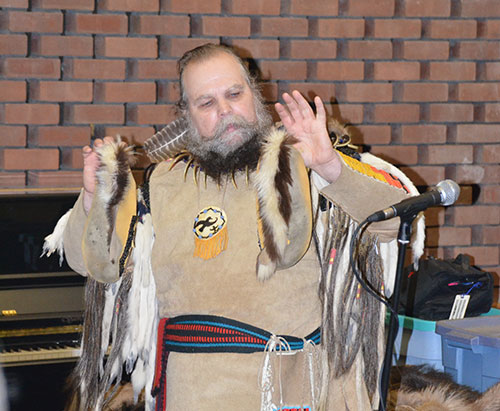
By Scott Allen
The Scene staff
The art of storytelling is one that Jim Two Crows Wallen works to keep alive every day.
The Cherokee-descendent spoke at Forest Park on April 8, part of an Intercultural Arts Festival presented by the Global Education Committee and the art, communication and music departments.
Wallen, of Kansas City, Mo, told tales of his Native American ancestors to a crowd of about 100 students. Storytelling is his full-time job; he travels around the Midwest to give talks and performs or tells stories at 19 historical events each year.
“I took a love of history and a love of heritage and put together the presentation I’m giving today,” Wallen said.
Communications major Taylar Wafford, 23, was in the audience.
“I thought it was awesome,” she said. “I feel like I learned a lot about how many tribes there were then and there are today.
“I’m going off an hour of sleep, and I still stayed awake,” she added.
The Intercultural Arts Festival included several speakers at the end of March and in April.
“We wanted to bring in a different perspective on campus,” said Sandra Osburn, communications department chair. “Storytelling and even story listening is a disappearing art.”
Among the speakers was Debra Allen, an instructor of oral communication and public speaking at Meramec, who spoke at Forest Park on April 9. She said she wanted to speak at the festival because of her love of teaching.
“For me, my life is about giving back now,” Allen said. “Teaching does that, I think. I learn so much from my students.”
Allen told students about her life as a welfare mom and as a “stop and drop” student at Forest Park, until she finally pushed through, finished her classes and eventually earned her degree from Webster University.
“I’m able to share my experiences, and that really is key for me,” she said.
Allen recently wrote a book called “The Church of Forgiveness.”
“It’s about a journey of learning to forgive,” she said. “The biggest forgiveness I’ve achieved is forgiving myself, and understanding and awareness of myself.
“And now I think I’m pretty fabulous.”
Wallen said he grew up listening to great Native American storytellers.
“It was a wonderful experience, growing up with an oral heritage like that,” he said.
He explained his drive to keep oral history alive.
“We’ve lost a couple generations of stories. It used to be … a storyteller was worth his weight in gold,” he said. “It’s very important that we keep our family history alive, no matter what culture you’re from, no matter what ethnic background you have.”
Like many Cherokee, Wallen’s ancestors were forced to join in the Trail of Tears, the relocation of Native Americans from the southeastern United States, following the Indiana Removal Act of 1830.
The storyteller showed students furs from a skunk, raccoon, beaver, deer, wolf, bear and a buffalo.
“In the mid-1800s, the fur trade was more important than agriculture in St. Louis,” said Wallen, noting the St. Louis Fur Company and Rocky Mountain Fur Company were headquarted in St. Louis.
The furs would go as far as away as London and Paris for hat-making.
Fur traders, Wallen explained, would trade blue “trade beads” to Native Americans. The Native Americans couldn’t make blue beads, so traders might have received 10 furs, worth $100, for one bead, worth one cent.
A deer hide, Wallen said, was worth one “buck.” That’s where the expression for a dollar originated. The website Snopes.com offers the same story.
Hunters, Wallen said, would wear a wolf hide over their heads and backs and crawl up to a buffalo herd. The buffalo tolerated wolves because they kept the herd in its prime by killing the weak.
The hunters could shoot many buffalo that way, using bow and arrow, and feed their families for months from one hunt.
“The buffalo were extremely important to the Native Americans,” said Wallen, adding that their hides stretched 10 or 12 feet and could weigh over 100 pounds.
Wallen will be in St. Louis next for the Storytelling Festival, May 1-3, at University of Missouri-St. Louis, and the Lewis and Clark Heritage Festival in St. Charles on the third weekend of May.
He said he hopes to inspire some future storytellers.
“If we don’t know where we’ve been, where our stories come from, then how in the world will we know where we’re going?” he said.
The next and final Intercultural Arts Festival event is “C4: The STL Comics Explosion,” from 1:30 to 2:30 p.m. Monday in Café West at Forest Park.
